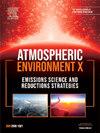A comparison of turbulent CFD with Gaussian dispersion models on a methane emission test site
IF 3.4
Q2 ENVIRONMENTAL SCIENCES
引用次数: 0
Abstract
This article investigates the influence of structures on the atmospheric transport of methane in an outdoor industrial environment, and provides a comparison in the predictive capability of Gaussian dispersion models against a turbulent computational fluid dynamics (CFD) model, implemented in OpenFOAM. Direct atmospheric measurements from the Methane Emissions Technology Evaluation Center (METEC), as well as a detailed computational mesh of on-site structures, are used to calibrate the turbulent closure model. By comparing the CFD model with and without the computational mesh of structures, it is shown that structures on METEC exhibit only a small effect on concentrations predicted by the CFD model. The calibrated CFD model is then used to assess the fidelity of the commonly employed Gaussian puff model that ignores the effect of any structures or topography. Despite the presence of structures, the Gaussian puff model is in consistent agreement with predictions from the CFD model, however both models fail to capture certain trends in the measurement data. To show that one cannot conclude, in general, that methane transport is unaffected by structures, a simulation study is performed with an emission source placed upwind of a large structure. In this case, it is found that predictions from the Gaussian puff model can deviate significantly from the CFD model due the Gaussian model’s inability to resolve spatially inhomogeneous wind fields caused by structures. This finding highlights the continued importance of CFD modeling for evaluating atmospheric dispersion models in environments with complex structures and topography.
甲烷排放试验场湍流CFD与高斯色散模型的比较
本文研究了室外工业环境中结构对甲烷大气输送的影响,并将高斯色散模型与OpenFOAM中实现的湍流计算流体动力学(CFD)模型的预测能力进行了比较。来自甲烷排放技术评估中心(METEC)的直接大气测量数据,以及现场结构的详细计算网格,用于校准湍流闭合模型。通过对CFD模型中有无结构计算网格的比较,表明METEC上的结构对CFD模型预测的浓度影响很小。校正后的CFD模型用于评估忽略任何结构或地形影响的常用高斯泡芙模型的保真度。尽管存在结构,但高斯喷流模型与CFD模型的预测一致,然而这两种模型都未能捕捉到测量数据中的某些趋势。为了证明一般情况下不能得出甲烷输运不受结构影响的结论,我们进行了一项模拟研究,将排放源置于大型结构的逆风位置。在这种情况下,发现由于高斯模型无法解决由结构引起的空间非均匀风场,高斯扑烟模型的预测结果与CFD模型有很大的偏差。这一发现强调了CFD建模在复杂结构和地形环境中评估大气弥散模型的持续重要性。
本文章由计算机程序翻译,如有差异,请以英文原文为准。
求助全文
约1分钟内获得全文
求助全文
来源期刊

Atmospheric Environment: X
Environmental Science-Environmental Science (all)
CiteScore
8.00
自引率
0.00%
发文量
47
审稿时长
12 weeks
 求助内容:
求助内容: 应助结果提醒方式:
应助结果提醒方式:


